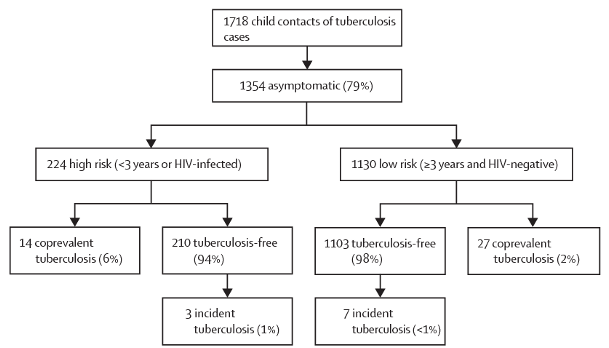Corresponding Author: Andreas Handel, andreas.handel@gmail.com

For infectious diseases, especially diseases that are spread from person to person by droplets in the air produced by coughing or sneezing, determining the contact rate and tracing the contact network provides important information for implementing effective health interventions. One such disease, tuberculosis (TB), is a leading cause of global childhood mortality, yet, due to the lack of resources child contact tracing, there are few intervention strategies to detect undiagnosed tuberculosis in children. In a recent article, the World Health Organization (WHO) presented an assessment of the effectiveness of a practical screening approach for managing child contacts by identifying secondary TB in a prospectively followed cohort study of Ugandan child contacts. The study showed that the symptom-based algorithm was an effective tool for identifying cases, especially in children below the age of 5. Their modified decision-tree also identified 6% of asymptomatic child contacts at high risk for subclinical disease. This article exemplifies the increasing use of decision tree methodology in infectious disease studies to create a classification system for developing algorithms that predict certain outcomes. In many cases, these decision trees can be used for the diagnosis of a medical condition from a pattern of symptoms. This method is an efficient way to effectively deal with large, complicated data sets, such as the ones used in this long-term cohort study. In this study, the use of a modified decision tree produced an effective algorithm that helped identify children with TB, based off a system of various symptoms associated with the disease. Continuing to construct feasible decision tree models to target high impact infectious diseases like TB has important health implications for populations and communities across the globe that continue to suffer the burdens of these diseases.
Martinez, Leonardo, et al. “Effectiveness of WHOs Pragmatic Screening Algorithm for Child Contacts of Tuberculosis Cases in Resource-Constrained Settings: a Prospective Cohort Study in Uganda.” The Lancet Respiratory Medicine, vol. 6, no. 4, 2018, pp. 276–286., doi:10.1016/s2213-2600(17)30497-6.
Featured Image by Vicki Nunn [Public domain], from Wikimedia Commons